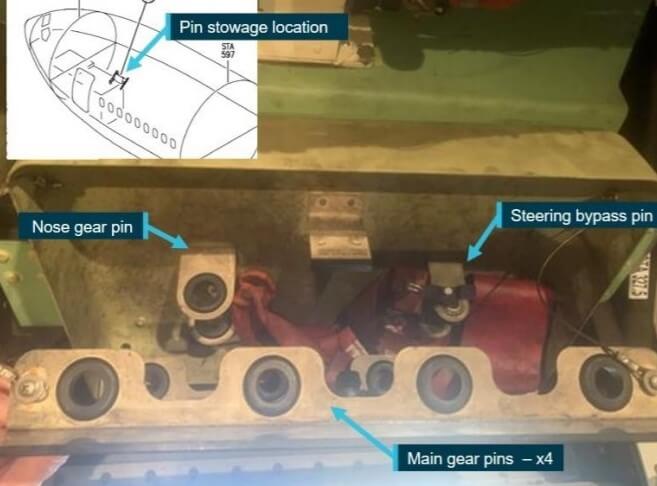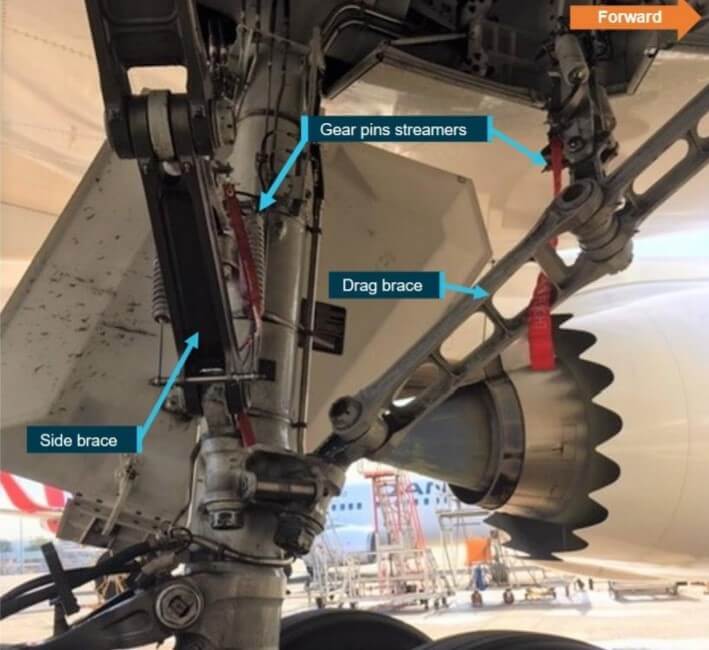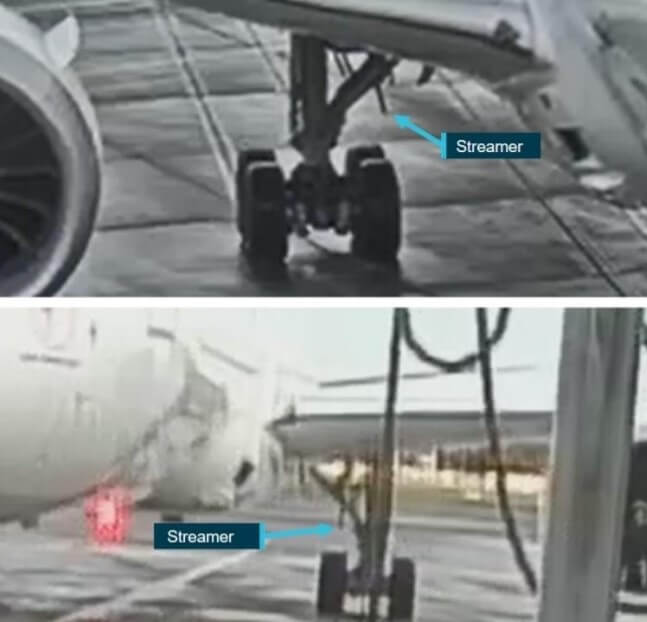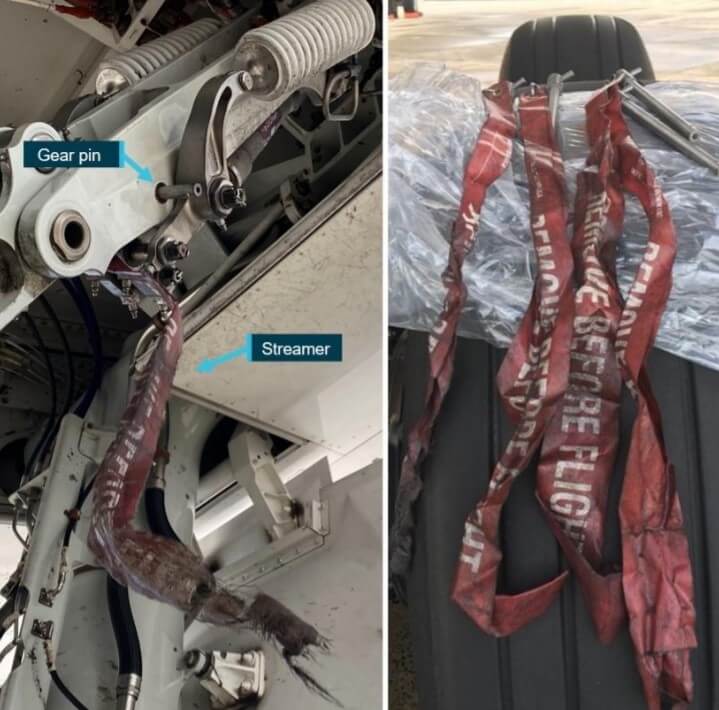A Qantas Airways Boeing 787 aircraft was scheduled to fly 119 passengers from Sydney to Perth, Australia. But a few moments after departure from Sydney Airport (SYD), the flight crew reported an issue with the main landing gear and were unable to retract it after a takeoff.
Australian investigators found that the incident was caused by multiple human errors, after the failure to remove two pins on the left and right main landing gear before takeoff. This resulted in the main landing gear malfunctioning inflight.
Human error
The incident happened on the morning of June 21, 2021, when Qantas Airways Boeing 787-9 jet, registered as VH-ZNH, was performing a scheduled flight QF-645 connecting Sydney (SYD) and Perth Airport (PER). According to the final investigation report, released by the Australian Transport Safety Bureau (ATSB) on November 16, 2021, the Qantas Engineering staff team towed the aircraft from the parking zone to the assigned airport terminal bay. The tow crew consisted of a tow-motor driver, two wing walkers, and a person in charge (PIC), who was responsible for coordinating the towing process with the ground crew and the flight deck.
Two engineers were on board the aircraft, including a licensed aircraft maintenance engineer (LAME) and an aircraft maintenance engineer (AME). While the LAME was acting as flight deck operator (FDO) and was responsible for ensuring a correct plane configuration during the tow, the AME was undergoing informal general familiarisation training.
When the jet arrived at the assigned bay, the staff placed chocks at wheels and unhitched the tow-motor. Then, the PIC removed a downlock pin from the nose gear, walked to the rear of the aircraft, and removed another from the right main gear. At the same time, one of the wing walkers removed a gear pin from the left main gear. However, it was the first time that either the PIC or the wing walker had towed the Boeing 787 jet, so the PIC asked the LAME for guidance on where to stow the pins on this particular type of aircraft.
Instructed by the LAME, the AME advised the PIC that the pins on the 787 are stored in the electrical equipment center (EEC), which is located on the aft side of the nose gear. The AME also told the PIC to leave the removed pins on the nose gear, so the LAME would stow them when the aerobridge arrived.
Commonwealth of Australia
Although the PIC was instructed to leave the pins on the nose gear, he put three removed gear pins into the EEC and, together with a wing walker, left the aircraft.
When the LAME and AME were leaving the jet, the LAME saw that the nose gear pin had been removed, but did not notice any irregularities. So, the LAME instructed the AME to confirm that the gear pins had been removed and stowed in the assigned place. The LAME signed the necessary papers in the tech log and returned the documents to the plane.
Additionally, no irregularities were noticed even after the arrival of the flight crew, consisting of the captain, the first officer, and the second captain. The second captain assumed the role of relief pilot and was in charge of conducting the external inspection of the plane. However, he did not identify any issues and nothing was found to be wrong with aircraft during the pre-flight landing gear system checks.
Once all necessary ground services had been completed, just before the pushback, the dispatch crew, which consisted of a supervisor and a trainee, made the final external inspection. Again, nothing suspicious was found, and the Boeing 787 was cleared to depart.
Commonwealth of Australia
Two missed pins result in the main landing gear malfunctioning inflight
Shortly after take-off, the first officer turned the landing gear selector to the UP position. But, after 10 seconds, the flight crew received a Gear Disagree caution on the Engine Indication and Crew Alerting System (EICAS), which was followed by an aural alert.
The EICAS indication alerts the flight crew about the position of each gear. It can be positioned either in the UP, in-transit, or DOWN position.
On the day of the incident, the flight crew observed that the nose landing gear had retracted, but both main landing gears continued to display a grey crosshatch symbol, which meant that both remained in the in-transit position. Once the irregularity was noticed, following Qantas Airways procedures, the pilots commenced a Gear Disagree EICAS procedure, reported a landing gear problem to the Air Traffic Control (ATC) and stopped climbing at an altitude of approximately 9,000 feet to complete the Gear Disagree checklist.
The pilots attempted to solve the issue by selecting the DOWN and then UP positions, but the move did not help. As a result, the flight crew positioned the jet for the approach to SYD airport and landed around 30 minutes after departure.
Was the incident caused by the COVID-19 pandemic?
The ATSB stated that, as a result of ongoing COVID-19 pandemic restrictions, in February 2021, voluntary redundancies were offered to affected personnel. Later, Qantas Engineering offered some of its engineers the opportunity to transition into new roles on new aircraft types. The investigation found that only one of the Qantas ground crew that spoke with the authority, the Boeing 787 LAME, advised were aware that the 787 had five gear pins instead of three.
Meanwhile, investigators also stated that it was the first time the entire ground crew, except the 787 LAME, had towed this type of aircraft. The investigation disclosed that one wing walker was a LAME on Boeing 737, Boeing 747, and Airbus A330 jets, while the PIC and the AME held licenses to operate on the A330.
The ATSB report notes:
“Two of the five landing gear pins were not removed as per the operator’s procedures, nor identified by engineering, flight crew, or dispatch during pre-departure checks. This resulted in the aircraft departing without the functionality to retract the main landing gear.”
The ATSB also reported that despite the first officer being aware of the five pins, neither he nor the second captain had seen those pins installed, as they are typically removed before the flight crew makes their external aircraft inspection.
The dispatch crew confirmed to the ATSB that they were aware of the five gear pins on this type of aircraft and had occasionally seen these pins installed. They reported that on the day of the incident their duties included a check of all ground equipment, the inspection of the plane for the security of doors and panels, and the presence of any streamers.
The dispatch crew also told investigators that they would install the steering bypass pin, which was located near the nose gear pin when the tow-motor was connected. Then, they would remove it when the tow-motor was disconnected, following pushback. The staff explained that if the nose gear pin had still been in place, it would have been an indication for the supervisor and trainee to check that all other gear pins had been removed.
However, since the nose gear pin had already been removed, and the dispatch crew had not been in a situation where pins had only been partially removed, the supervisor concluded that all five pins had been put in the assigned place.
Commonwealth of Australia
The ATSB conclusions
Australian investigators concluded that the incident was caused due to multiple human errors, which later resulted in the flight crew’s inability to retract the main landing gear after departure.
One of the main reasons for the incident was that the tow crew were unaware that the aircraft was installed with five pins instead of three. Another significant mistake was made by the LAME, who was aware of the five pins but failed to confirm that they had all been removed and stored before signing the jet’s tech log. In addition, the ATSB concluded that the AME completed a physical pin check while unaware of the exact number of items to expect.
Furthermore, the pilots and the dispatch crew conducted the external inspections with no expectation of finding streamers indicating gear pins were still installed. According to the authority, false assumptions were made because the documents in the aircraft tech log were already signed by the LAME, leading both the flight and dispatch crew to believe that all five pins had been successfully removed by the Qantas Engineering staff.
Commonwealth of Australia
Qantas Airways responds
Reacting to the investigation, Qantas have taken action to ease the verification process for pin stowage on the Boeing 787 aircraft. Qantas Airways also relocated the pin stowage from the electrical equipment center (EEC) to the flight deck, in line with other jet types operated by the airline.
The Australian carrier also released memos dedicated to engineering, flight, and ramp crew, where the company highlighted quantity and the exact location of the gear pins on the particular aircraft type. The carrier also emphasized the importance of checking the pin location rather than relying on streamers. In addition to these preventive actions, the airline also updated its training packages for engineering, dispatch, and flight crew.




